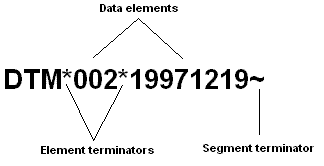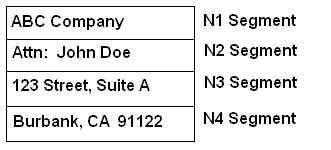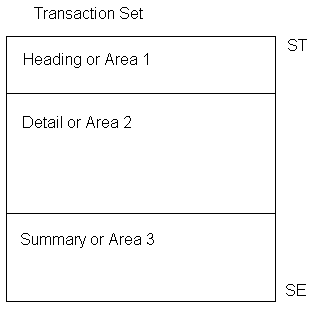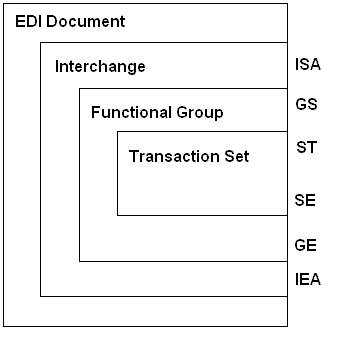What is EDI?
EDI Definition
EDI or Electronic Data Interchange is the exchange of data in a standard format between computers without any human intermediary.
A PowerPoint Show about the Basics of EDI
EDI Standards
Two widely used standards are X12 (commonly used in U.S.A. and Canada), and UN/EDIFACT (commonly used in Europe and the rest of the world).
EDI Processes
A typical EDI exchange involves the following processes:
Outbound Process
The Outbound process is the generating and sending of EDI files. Below are the steps of an outbound process.
1. Obtain data from existing system.
2. Generate EDI file.
3. Validate EDI file.
4. Send EDI file to trading partner. Some common methods of transmission are FTP, HTTP and AS2.
Inbound Process
The Inbound process is the receiving and translating of EDI files. Below are the steps of an inbound process.
1. Get EDI file.
2. Validate and acknowledge EDI file be sending back a TA1, 997 or CONTRL EDI file.
3. Translate EDI file.
4. Save data to a database.
The EDI file structure
An EDI file is a binary computer file that contains data arranged in units called data elements. Data elements are separated by element terminators; and a group of data elements make up a data segment. Data segments are separated by segment terminators.

Figure 1: An example of a data segment (DTM) having two elements.
Some elements (known as composite elements) are made up of sub-elements (component elements).

Figure 1a: An example of a data segment (SV1) having four elements. The first element is a composite element with two sub-elements (or component elements) separated by a component element separator, which is ":" (a colon).

Figure 1b: A section of an EDI file with segments ISA, GS, ST, BEG, REF, ITD, DTM, N1, N2, N3, N4
A block of data segments with data that are inter-dependent to each other is called a group or a loop. An example of a loop is the N1 loop, which may hold a company's address information.

Figure 2: An N1 Loop

Figure 2a: A section of an EDI file with three instances of the N1 loop. The first N1 loop consists of segments N1,N2,N3,N4. The second and third instances of the loop consist of segments N1,N3 and N4.
The section of data segments that convey a message is called a Transaction Set or Message. The message itself is sectioned into tables (or areas): the header (or Area 1); the detail (or Area 2); and the summary (or Area 3).

Figure 3a: An X12 Transaction Set structure Figure 3b: A UN/EDIFACT message structure
Transaction Sets (Messages) can be organized by grouping them by their topics or functions. A group of Transaction Sets is called a Functional Group. Functional Groups themselves constitute an interchange. An Interchange is an electronic equivalent of a letter envelope. It contains the destination and sender ID of the EDI message, and the date/time stamp of when it was sent.

Figure 4a: The ASC X12 file structure Figure 4b: The UN/EDIFACT file structure
The Control Segments are the header and trailer segments that mark the start and end of their controlling structure.
- The Header/Trailer control segments of the Interchange are the ISA/IEA in X12, and UNB/UNZ in UN/EDIFACT.
- The Header/Trailer control segments of the Functional Group are the GS/GE in X12, and UNG/UNE in UN/EDIFACT.
- The Header/Trailer control segments of the Transaction Set are the ST/SE in X12, and UNH/UNT in UN/EDIFACT.
Figure 5a: An example of an ASC X12 EDI file
Figure 5b: An example of an UN/EDIFACT EDI file
For more details about the differences between X12 and UN/EDIFACT, please read EDI X12 vs. UN/EDIFACT
The Implementation Guideline
EDI files cannot be successfully exchanged without an implementation guideline that has been agreed on by the trading partners. An implementation guideline is a documentation with a set of rules defining a company's EDI file and how it should be processed.
For the EDI standard to support all industries and different systems, the standard allows the flexibility for companies to incorporate their requirements into the standard. These conventions are documented into the implementation guideline. Therefore the steps to translate an EDI file normally involves the following:
1. Parse the EDI file following the standard to obtain data from the EDI file.
2. Map the data obtained from the EDI file to a database using the instructions from the implementation guideline.
The steps to generate an EDI file normally involves the following:
1. Obtain data from existing system and map them to the standard format following your trading partner's implementation guideline.
2. Construct the EDI file following the standard's rule.
For more details about the implementation guideline, please read Creating an EDI Implementation Guideline.
For a PowerPoint Show about the Basics of EDI, click here.
Click here to evaluate the Framework EDI

Related Topics


